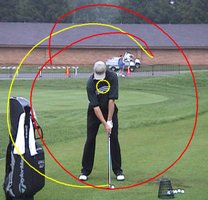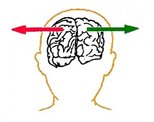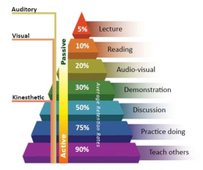“I never lose! Either I Win or I Learn” ~ Nelson Mandela
Click on PDF symbol if you like to see the advanced learning levels.
Stages of learning
To better understand “Learning” I would like that you familiarize yourself with the three
stages of learning. Once you understand the learning process you will learn quicker
with a lifetime lasting result.
It is up to us to discuss the different learning stages. Once this is done and when we
understand that there is a great deal of work ahead we must find out how we shall
communicate, i.e. what learning-senses you prefer for this. You can read more about
this in the chapter “What learning type" are you?
To simplify the way we understand how golf education and learning works, I prefer to present the learning progress in the following three stages.
There are many of us who are impatient in making progress, in changing and improve our swings, putting etc, as well as in achieving results.
Some people like to practice and other prefer to play on the course. To make any changes in your swing you have to spend time on the practice area with constructive and planned practice. It is quality not quantity that counts!
Knowledge of what and how you should do something together with
understanding is what form the first stages of learning. Once the brain knows what to do,
the understanding and results are achieved quickly. A few hours……
Have you played previously and like to make changes and improvements, you have to
take away the old bad compensations, (bad habits) in your old technique and work
on the things that have to be corrected so you can learn to swing freely in the
correct plane and swing path.
You will swing “IN THE BIG WHEEL” freely and with high swing-speed without needing of corrections.
“Quick fixes will never work”!
We remember and learn best with "See - Hear - Do"
And now advancing to stage 3. After extensive constructed practice, your motor skills will become automatic and effortless and you will no longer rely on your conscious control. Your antagonist muscles will not be connected in your swing and all movement will happen freely and naturally, your grip will be relaxed and you will also start to notice other things like the wind conditions, texture on greens and other obstacles. You will free a lot of energy so you can concentrate on course management and improved scoring.
It is when we have reached this point the golf becomes real fun and I hope you have the patience to pass these three stages as early as possible.
All stages I talked about here are also valid for putting, short-game, bunker-shots etc.
Further down on this page you can see the graph “students remember”. Out of this I know that you learn very little from just reading.
Another one: How to Learn to Learn will introduce you to Mental Training, a tool that can help you..Anyway, ….. I hope that you find my WEB interesting and get curious how to become a much better golfer by using the “see, hear and Do, (The understanding comes by itself after a while). Avoid the brain to make translations like in normal tuition.
In the real world there are five stages of learning and it works differently for different personalities. Further down on the page you can learn more about the advanced way of seeing the learning cycles. The five stage presentation is mainly for Tour players, Coaches and Instructors.
If you click the PDF symbol you can read the complete advanced learning levels, the scientific way. They are correct but complicated, very complicated. If golf is your “living”, you are a Tour Player, Coach or Instructor you need to know them so here they are:

Corrections shall be made in or as close as possible in real time

The Big Wheel
What Learning type are you?
When learning we normally use the most suitable learning-sense for the moment. We are all
different so we use different senses in learning which are called representation senses. There
is a great deal of difference between us all with respect to genetic make up, temperament,
environment etc. Other things also affects the learning such as behavior, stress, aging etc.
The representation system works parallel with your different senses. We are not aware of that
we, for example think in pictures or hear things inside us. Some people are visual, some auditive,
while others are kinesthetic or analytical. When you learn, you use a combination of these senses. Most people have some sense or senses that are stronger than the others and if we know this before we start our teaching and coaching, we can focus on that. If you are strong in visual learning you prefer pictures and if you are kinesthetic, we have to consider this. With this knowledge, your learning will be quicker, more
understandable and more fun for both of us.

Visual?


A leading Scandinavian Sport Psychologist has done an easy
test showing you and me what senses you prefer in the learning.
What senses do you prefer? What are your strong sides? This is important for both of us as we must be able to communicate with each other (using the right learning channels) in the best possible way.
Make the test, its easy and takes approximately 15 minutes. Then we both know what senses to us for your best learning.
Kinesthetic?
Auditive?
The Learning Sense Test is FREE. After you have done it, YOU KNOW what senses you prefer in Learning.
Just click The PDF linkto download and printthe test out.

Left and Right brain have different
functions in the learning process
You place 100 points on 10 different “questions”. Be honest, go for the answer you feel is right for you. After the questions you fill in the points on the chart at page 4, add them together and find out about your preferable senses for learning. Now you get a clear picture what type of learning you prefer. On the last page you will find general answers to the different types. The test is produced by S. Sehested.
There is therefore no standard swing. Our bodies, physique, temperament, intellect are different and therefore we must have different grips, line-ups, stances, etc.
An excellent swing for you will therefore both be and look different compared to others. You build your own swing from Basics.
Purposeful training with realistic intermediate goals and good practice planning. Your learning never ends.
A constructive commitment and planning is necessary.
You decide what level you want to reach. Happy amateur golf, National Teams or The Tour. This and the level of your commitment determines how far you will go.
When you play on the course or practice on the Range or other practice areas, it is important that you realize from the start that: All Golf-shots should have have a purpose, both in play and practice.
So the first part of any education is to understand what you shall achieve. The knowledge and recognition of a realistic goal and the steps who will lead you there is normally more important in the beginning and we always must assure before we move on to the next stage that you understood the previous item.
Its all in the education and when you put knowledge together with practice you are learning.
The learning will go much quicker, and most of all, with involvement you start to enjoy the learning and it is lasting changes.
The learning pyramid confirms clearly that Lecture & Reading gives lower learning.
Audio - Visual - Demonstration and Discussion (involvement) gives much better learning.
Practice and working on your changes "in tandem" you get involved
and learning will come easier and quicker.
Another example of a visual way of learning is to do like children does. They Look,
(imitate) and Copy!
One reason that a young boy or girl for example can learn to bicycle so quick is that they study
other children and notifies how they do it. Therefore their brains know pretty well and have a picture of what they shall achieve and how it works when the time comes.
They fall a few times and then ..... it works. The understanding of the "how and why:s" comes later.
When teaching golf it can be very helpful for you to see a movie or a good demonstration of what you shall work on "the coming hours".
Many times a movie in normal and slower speed is best as we accept it and it don't generates disturbing questions for the brain. Mostly it generates curiosity and involvement.

Mental training can help you Learn and Perform Better
Mental training is a way for you to prepare yourself mentally and physically to perform and stimulate the Learning process.
Try to get professional advise from start if you are aiming high. There are many good coaches around.

With mental exercises you will build confidence, learn to use Goal Pictures, Focus,
Motivation, Self- believes, understand the Mental Room and more things for
your future golf performance.
On the page SPORT PSYCHOLOGY, After the Chapter: For Golfers Aiming to the Stars you have an example of
a good start. It is a complete mental Training program for golf from Monkeymindset. Peak Your Performance.
You have it there for FREE.
I hope it stimulates your golf and can give you a start.
Other systems for performace is Hearth Math, Breathing exersise, connecting Heart and Brain and stimulates the nervous system. There are also TM and a few others.
Copyright © Tamber Golf 2024